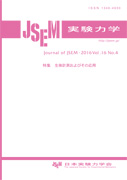Volume 16, Issue 4
Displaying 1-8 of 8 articles from this issue
- |<
- <
- 1
- >
- >|
Original Papers
-
2017Volume 16Issue 4 Pages 295-300
Published: January 23, 2017
Released on J-STAGE: January 23, 2017
Download PDF (10106K) -
2017Volume 16Issue 4 Pages 301-306
Published: January 23, 2017
Released on J-STAGE: January 23, 2017
Download PDF (1894K) -
Dynamic Viscoelasticity Properties Evaluation of Skin and Making of Dummy Skin for Safety Evaluation2017Volume 16Issue 4 Pages 307-314
Published: January 23, 2017
Released on J-STAGE: January 23, 2017
Download PDF (3872K) -
2017Volume 16Issue 4 Pages 315-319
Published: January 23, 2017
Released on J-STAGE: January 23, 2017
Download PDF (6529K)
Original Papers
-
2017Volume 16Issue 4 Pages 320-325
Published: January 23, 2017
Released on J-STAGE: January 23, 2017
Download PDF (1368K) -
2017Volume 16Issue 4 Pages 326-331
Published: January 23, 2017
Released on J-STAGE: January 23, 2017
Download PDF (1545K) -
2017Volume 16Issue 4 Pages 332-341
Published: January 23, 2017
Released on J-STAGE: January 23, 2017
Download PDF (17975K) -
2017Volume 16Issue 4 Pages 342-347
Published: January 23, 2017
Released on J-STAGE: January 23, 2017
Download PDF (5226K)
- |<
- <
- 1
- >
- >|
